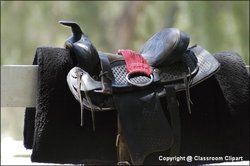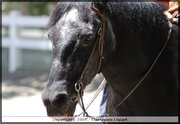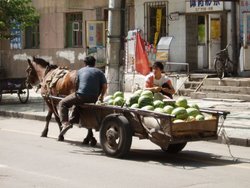Horse tack
|
|
Tack is any of the various accessories worn by horses in the course of their use as domesticated animals. Saddles, stirrups, bridles, halters, reins, bits, harnesses, martingales, and breastplates are all forms of horse tack.
| Contents |
Saddles
Saddles are seats for the rider, fastened to the horse's back by means of a girth or cinch, a wide strap that goes around the horse at a point about four inches behind the forelegs. Some saddles will also have a second strap known as a flank cinch that fastens at the rear of the saddle and goes around the widest part of the horse's belly.
It is important that the saddle is comfortable for both the rider and the horse—an improperly fitting saddle may rub and cause the horse pain and eventual injury. Usually a saddle will be inspected annually and the stuffing modified to correct the fit.
There are many types of saddles, each specially designed for its given task.
- English Saddles
- Jumping Saddle
- Dressage Saddle
- Polo Saddle
- Park Saddle
- Racing Saddle
- Western Saddle
- Roping Saddle
- Barrel Racing Saddle
- Endurance Saddle
- Sidesaddle
- English Sidesaddle
- Western Sidesaddle
- Military Saddle
- Australian stock saddle
Stirrups
Stirrups are supports for the rider's feet that hang down on either side of the saddle. The invention of stirrups was of great significance in mounted combat, giving the rider a secure footing while on horseback. At the same time the stirrups are problematic due to the tendency for feet to get stuck in them in dire moments, causing the rider to be dragged. Because of this danger saddlers have developed both safety stirrups—which are either shaped to allow the rider's foot to slip out easily or are closed with a rubber band—and safety stirrup bars that are hangers for the stirrup leather that allow it to detach from the saddle in an emergency.
Bridles and halters
Bridles and halters are an arrangement of straps around the horse's head used for communicating with the animal. Bridles contain a bit attached to reins and are used for riding and driving horses. On the other hand, halters have no bit, are more general-purpose, and most often equipped for leading (particularly pack horses) or tethering a horse with one rein. A hackamore is a type of bitless bridle.
Double bridles, like a bradoon or a Weymouth, use two bits in the mouth at once. The two bits allow the rider to have very precise control of the horse; usually only very advanced horses and riders use double bridles. Double bridles are usually seen in the top levels of dressage, as well as for showing purposes.
A lungeing cavesson is a special type of halter used for lungeing a horse. Lungeing is causing a horse to walk, trot and/or canter in a large circle around the handler. It is used for training and exercise.
Reins
Reins consist of leather straps or rope attached to the outer ends of a bit and extend to the rider's or driver's hands. Reins are the means by which a horse rider or driver communicates directional commands to the horse's head. Pulling on the reins can be used to steer or stop the horse. The sides of a horse's mouth are sensitive, so pulling on the reins pulls the bit, which then pulls the horse's head from side to side, which is how the horse is controlled.
On some types of harnesses there might be supporting rings to carry the reins over the horse's back. When pairs of horses are used in drawing a wagonor coach it is usual for the outer side of each pair to be connected to reins and the inside of the bits connected by a short bridging strap or rope. The driver carries "four-in-hand" or "six-in-hand" being the number of reins connecting to the pairs of horses.
A rein may be attached to a halter to lead or guide the horse in a circle for training purposes or to lead a packhorse.
Bits
A bit is piece of metal that is placed in the horse's mouth, although on occasion the bit may be made of other materials. Despite popular opinion, the bit does not rest on the teeth of the horse. The bit hangs in a space behind the front "cutting" teeth and in front of the back "grinding" teeth. This space is known as the "bar". When a horse is said to "grab the bit in its teeth" they actually mean that the horse hardens its lips and mouth against the bit to ignore the rider's commands. Bits offer varying degrees of control and communication between rider and horse depending upon their design and on the skill of the rider.
The types of bits are too numerous to list, but here are some examples:
- Curb bit
- Snaffle bit
- Gag bit
- Pelham bit
- Kimberwicke bit
Bits come in several different mouthpieces and (for snaffles) rings. Some of these include:
Mouthpieces:
- Single jointed
- Mullen mouth (straight bar)
- Dr. Bristol
- French mouth
- Corkscrew
- Single and double twisted wire
- Waterford
Rings:
- Loose ring
- D-ring
- Eggbutt
- Full-cheek
- Baucher
- Half-cheek
Bits are designed to work by pressure, not pain. Of course, in the wrong hands even the mildest bit can hurt the horse.
Harness
A harness is a complicated set of devices and straps that attaches a horse to a cart, a sledge or any other load. There are as many kinds of harnesses as there are vehicles and loads to attach to a horse.
For a horse that is used solely for draughting it will have a bridle, reins, collar and hames, and traces. A horse that is supporting shafts, such as on carts, will also have a saddle to support the shafts and a britchen to brake the forward motion of the vehicle, especially when stopping or moving downhill. Horses guiding vehicles by means of a pole, such as a wagon, a plow, or a dray, will have at least pole-straps attached to the lower part of their collar.
Martingales and breastplates
A martingale is a strap that (1) keeps the horse from raising its head above a point of control or (2) keeps the horse from tossing its head and smacking its rider in the face.
Martingale types include:
- Running martingale: There are 2 types: 1 has a yoke around the neck, a part that runs between the front legs and attaches to the girth of a saddle, and a fork at the chest that branches off and attaches to each rein, so that the bit presses on the bars of the mouth if the horse raises the head too high. 2- has a "yoke" around the neck, attaches to the girth, and either has a ring on each side of the yoke or a "fork" with a ring at each end, where the reins run through the rings, enabling the rider to more easily keep the horse flexed at the poll. Fitted correctly, this 2nd type of running martingale does not control how high the horse carries his head.
- Standing martingale: similar to the running martingale, but instead of a fork it has one strap that runs from the chest and attaches to the noseband of the bridle, and therefore has no affect on the bit in the horse's mouth. A western counterpart to this piece of equipment is the tie down. The standing martingale, however, does not provide as much freedom for the horse, which could be dangerous for cross-country riding. Therefore, when a horse is used for eventing it must use a running martingale for safety reasons, if a martingale is to be used at all.
- Irish martingale: Unlike the previous two martingales, this does not control the height of the horse's head, but merely keeps the reins from going over the horse's head in the result of a fall. It consists of a piece of leather with a ring on each end in which each rein runs through.
Breastplates, breastcollars, and breastgirths are all extra equipment used to keep the saddle from sliding back. They are usually seen in demanding, fast-paced sports like eventing, show jumping, and polo, as well as fox hunting. They are also seen in Western events, with a more decorative than utilitarian function.



